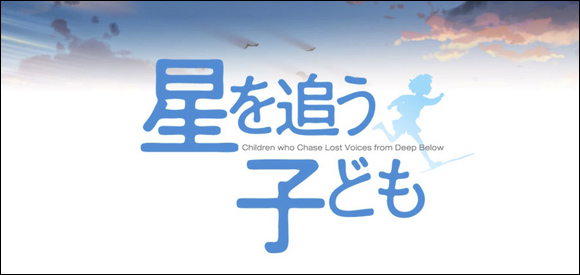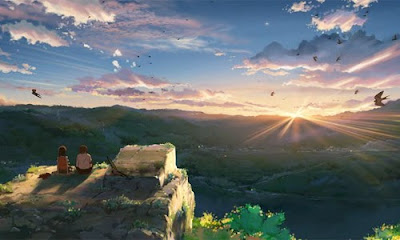Makoto Shinkai has been called the next Hayao Miyazaki, for good reason. In his newest work he creates an adventure narrative in the vain of the greatest of Miyazaki’s films, a departure from his extremely emotional love stories. By making a Ghibli-esuq film he is making a direct challenge to the master of Japanese animation but is it too early for him to be making such bold declarations or is this Shinkai clearly declaring his rightful place in the animation world? Asuna is a young girl who has been forced to mature early due to the loss of her father and the hectic schedule of her mother. She spends her time on the mountain listening to strange music from her crystal radio. One day a mysterious boy saves her from a beast, this starts her on a journey that brings her to the underworld Agartha and will lead her to a power capable of resurrecting the dead.

The film is gorgeous. Known for his fantastic art and attention to detail, Shinkai again creates some beautiful landscapes. There are dozens of frames in the film that deserve to be framed and hung on a wall, moments where I audibly gasped at the landscapes that Shinkai creates. Shinkai is probably the best artist currently working in Japan and he has poured all of his talent into crafting this film. When Asuna descends into Agartha we’re treated to the remnants of a once great civilization, here Shinkai builds magnificent ruins and gives them an unbelievable sense of scale. It can’t be understated how a meticulous use of background detail aids world and character building. Being able to see shelves and books, various containers, and other elements of life make the people of Agartha come alive. The creation of a lived in look to the villages and cities is comparable to Miyazaki’s towns in Nausccia and Princess Mononoke. The audience is immersed in this world completely. It feels alive.
One of the most exceptional images of the film is when Asuna reaches the edge of Agartha and sees a massive crater, the center of which is the gateway of life and death. Clouds hang over the crater and past it lies a flat desert. As the clouds hang above the crater the sun starts to peak over and the light transforms the entire horizon into a brilliant orange. The images shapes itself and one beautiful image transforms into a magnificent image as you watch. This is one of the best visual treats that Shinkai employs and it’s always stunning. He allows the subtle change in nature to tell a piece of the story, to define a bit of his theme, and to imbue the audience with a slight emotion. Again, Shinkai’s genius comes in attention to detail.
Asuna is a fantastic character and Shinkai spends the first part of the movie showing her daily life. Her relationship with her pet squirrel, how she takes care of the household chores, and prepares her own meals. Shinkai’s subtle use of visual narrative gives the audience a ton of information through quick visuals or background noise. Her mother isn’t around and a line is dropped that she’s working at a hospital, which conjures a host of images in the viewers head. During an early scene Asuna is seen praying at her Father’s shrine, so without beating the audience over the head with her circumstances the audience understands and is immediately sympathetic. The same can’t be said about most of the other characters of the film. Mr. Morisaki, who becomes the driving force of the journey into Agartha, has a rushed development and little is known about him before a twist has him on his way to the gate of life and death. Years of research and this life threatening journey are the result of the loss of his wife, who we never see and recieve no information about. We’re supposed to take it at face value that Morisaki would endanger a young girl, recruit a group of commandos, and recklessly journey across a dying world on foot in order to bring her back to life. His obsession is the driving force of the film, he is introduced by teaching the myth of Agartha to Asuna’s class long before we learn that he lost his wife. He also never speaks personally about his wife during the film, even after he becomes close to Asuna. This lack of any sympathetic qualities turns what should be a rich, sympathetic character into a flat obsessive villain.
Makoto Shinkai’s films are traditionally slow, which allows the characters and imagery to take center stage. “5 Centimeters per second” used imagery, narration, and dialogue to tell its story. “Children Who Chase Lost Voices from Deep Below,” being an action/adventure film can’t relay on those tropes that Shinkai has mastered. The first ten minutes of the movie do follow that pattern, as I wrote above much of
 Asuna’s characterization comes from Shinkai’s brilliant use of imagery. Once the action starts is where some of the problems begin. The pacing is extremely start-stop, never finding a consistent middle ground. Characters felt less that they were traveling in the epic world of Agartha and more that they were fulfilling plot points as they came along. This is where comparing Shinkai to Miyazaki breaks down. Most Miyazaki films stick to a strict structure which leaves room for great action while winding the pace down smoothly to explore the characters and insert humor. Shinkai hasn’t developed that ability yet, but the shortcomings in the plot and pacing aren’t large enough to ruin the film, it’s one of the failings that arises when attempting to compare Shinkai to the mastery of Miyazaki.
Asuna’s characterization comes from Shinkai’s brilliant use of imagery. Once the action starts is where some of the problems begin. The pacing is extremely start-stop, never finding a consistent middle ground. Characters felt less that they were traveling in the epic world of Agartha and more that they were fulfilling plot points as they came along. This is where comparing Shinkai to Miyazaki breaks down. Most Miyazaki films stick to a strict structure which leaves room for great action while winding the pace down smoothly to explore the characters and insert humor. Shinkai hasn’t developed that ability yet, but the shortcomings in the plot and pacing aren’t large enough to ruin the film, it’s one of the failings that arises when attempting to compare Shinkai to the mastery of Miyazaki.
Shinakai’s themes are always fantastic and “Children” is no different. The film is an extended metaphor for grief, the process of overcoming the death of a love one and what happens when someone isn’t able to let go. It’s a beautiful theme and well executed, the characters all come to a point where they have to make a difficult emotional decision and some fail that test. Even with the problems in characterization the desire that Morisaki had to bring a loved one back to life carries an emotional wight which is executed with profound skill.
Shinkai also adds a single sword fight to the movie, a quick minute long sword fight that happens near the end. It is perhaps the greatest action scene ever animated, comparable to the best action scenes from Princess Mononoke. Character movements are extremely fast and fluid, the choreography is exciting, and it feels like there is something serious at stake. Where most anime’s action scenes can come off as flashy Shinkai favors realism, as with his backgrounds, and captures the complex nature of humans in a physical struggle with the same profound skill he uses to craft his stunning landscapes.
Shinkai achieves near greatness with this newest film but by switching from his traditional style to a formula that strongly resembles that of Hayao Miyazaki he now enters an area where he is overshadowed by giants. However, the most exciting part about Makoto Shinkai is his age. When Miyazaki constructed his first “masterpiece” in “Nausicaa of the Valley of the Wind” he was forty-three years old. Makoto Shinkai is currently only thirty-eight. The exciting part about Shinkai is that his art is still developing. He already is one of the best animators working in Japan at this time and plenty of time to work on characterization, plotting, and other narrative failings of this film. So while some elements hold “Children Who Chase Lost Voices from Deep Below” back the career that this film foreshadows has me more extremely excited about the future of animation.
I recommend “Children Who Chase Lost Voices from Deep Below” as an enjoyable adventure story despite some of it’s narrative failings. However, the artistry in the film and the sheer beauty that scenes are animated make it an incredible visual experience. Even if the narrative doesn’t win you over the few scenes that make you gasp in delight will be well worth the investment.



It really was a wonderful film – a real experience. And it's certainly apt that you compared it to Miyazaki's work throughout, since his works (Princess Mononoke in particular) were such an obvious inspiration. Because of some of the weaknesses you mentioned, I felt mixed emotions when watching the film – and kind of back and forth (is this great or is it yet another "almost there" by Shinkai). But by the fantastic finish to the film, as things tie together and the theme is clearly emphasized, I realized I had watched Shinkai's best work and one that deserves to be mentioned alongside Studio Ghibli works.You're right – Shinkai's not quite there yet – not to the level of the great Ghibli works, but I think this movie show that he's maturing as a storyteller and writer, which is something I don't think I could say of his first two full films.
LikeLike